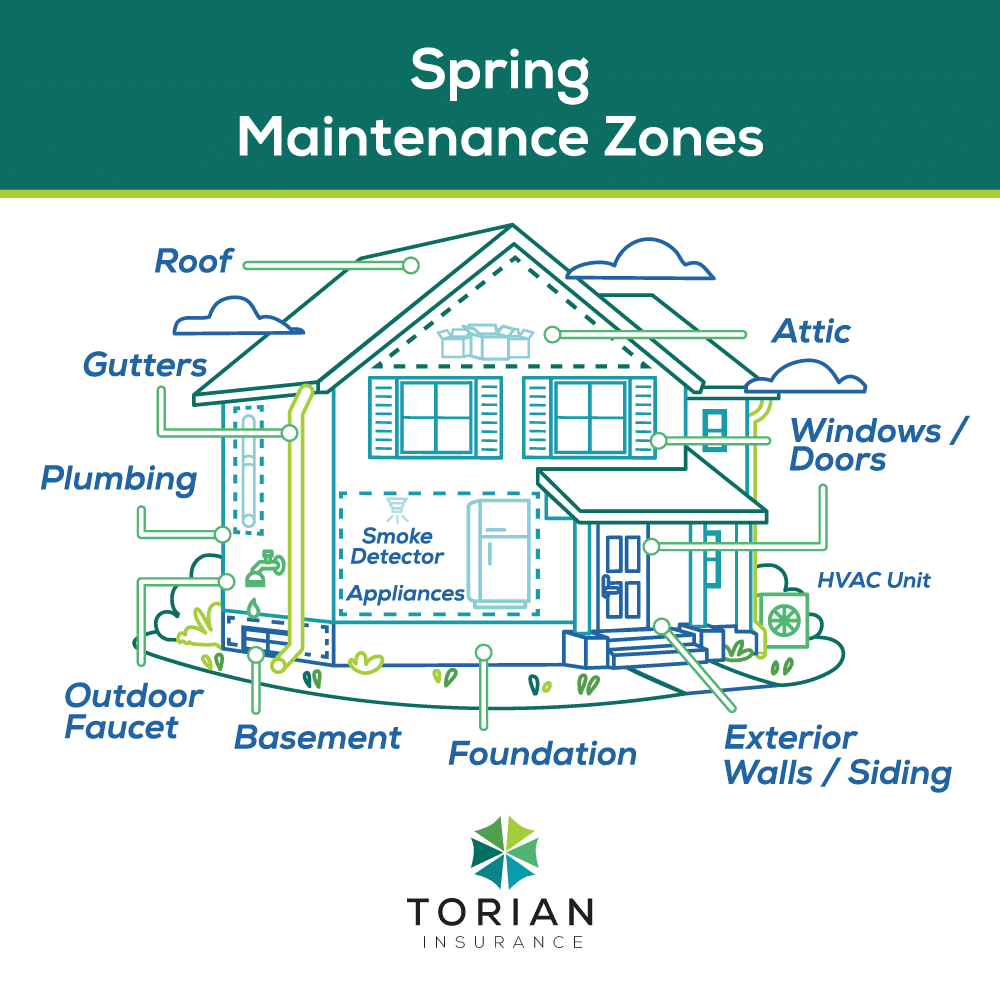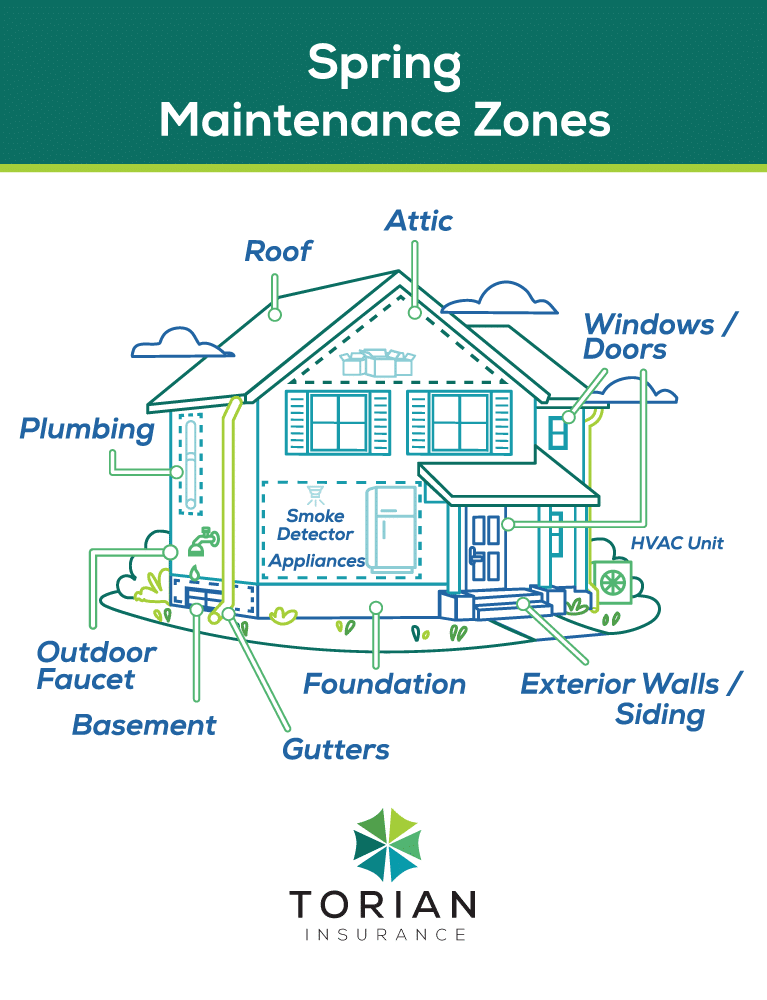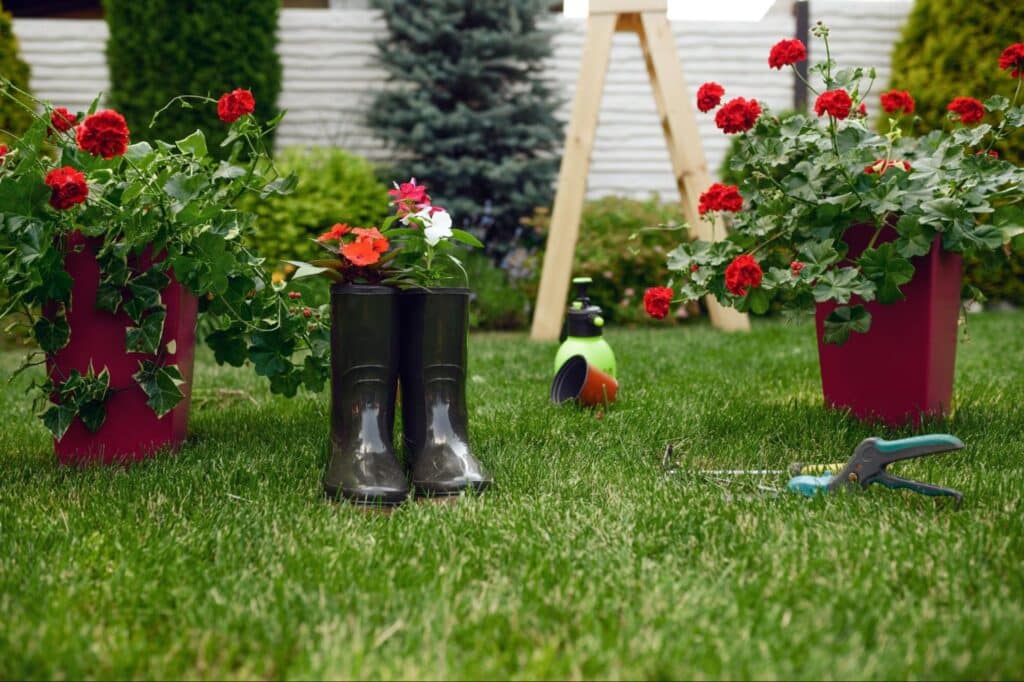Spring in Southern Indiana, Illinois, and Kentucky ushers in milder temperatures, blooming landscapes, and a chance to refresh and repair your home after the colder months. While the season can be a welcome relief from winter’s chill, it also highlights issues like aging roofs, clogged gutters, or leaky plumbing that developed during harsh conditions. Being proactive with spring maintenance is one of the most effective ways to protect your home’s value, comfort, and safety for the coming year.
As an insurance agency Evansville, IN homeowners trust, Torian Insurance understands the importance of staying on top of seasonal upkeep. Often, small home repairs can quickly balloon into major (and costly) headaches if left unaddressed. Proactive care not only reduces the likelihood of significant structural damage but also ensures that your home insurance policy remains a reliable safety net. Whether you’re worried about a cracked foundation, a worn roof, or just need a thorough spring cleaning plan, a consistent routine goes hand in hand with a solid insurance policy.
Below, we delve into essential spring maintenance tasks—both indoors and outdoors—to help you protect your home. We also highlight why partnering with the right insurance agency can make all the difference as you tackle seasonal challenges with confidence.
Benefits of Spring Home Maintenance
Spring home maintenance isn’t just about cleaning. It covers a range of tasks that preserve the value and functionality of your home:
- Prevents Costly Repairs. By catching minor issues—like small leaks or loose roofing shingles—you can stop problems before they snowball into expensive projects.
- Enhances Safety and Comfort. Regular checks and repairs lower safety risks around the home, such as fire hazards or potential slip-and-fall areas.
- Boosts Energy Efficiency. Simple actions like caulking around windows, updating insulation, and maintaining HVAC systems help reduce utility costs.
- Extends Lifespan of Materials. Maintaining exteriors and interiors ensures that structural components last longer, from roof shingles to wooden decks.
- Preserves Property Value. An attractive, well-maintained property tends to retain or grow in value, which can be beneficial should you refinance or sell.
- Reduces Unnecessary Stress. Having a plan for seasonal maintenance keeps surprises to a minimum and makes it easier to budget for repairs.
- Complements Insurance Coverage. Insurance policies function optimally when you maintain your home diligently, leading to fewer claims and a safer environment.


Essential Interior Maintenance Tasks for Spring
Deep Clean and Refresh
After winter keeps us indoors, dust and grime easily build up. A thorough home cleaning sets a healthier environment and brightens living spaces:
- Move furniture to vacuum underneath and around previously inaccessible areas.
- Clean window sills, tracks, and curtains to welcome fresh air and sunlight.
- Organize closets, removing winter gear you no longer need.
Check Safety Devices
Ensure that devices designed to protect you are in proper working order:
- Test all smoke alarms.
- Check carbon monoxide detectors.
- Replace the batteries if needed and verify the date of the last inspection.
Inspect Plumbing for Leaks
Spring is an ideal time to spot small plumbing issues before they escalate:
- Check under sinks for damp spots or water stains.
- Look around toilets and water connections for moisture.
- Examine your water heater for rust or leaks. If you notice any signs of wear, consult tips from water heater maintenance guides or call a professional.
Prepare Your HVAC System
As the weather shifts to warmer days, it’s critical to ensure your HVAC system functions properly:
- Replace or clean filters for better air quality and energy efficiency.
- Schedule a professional inspection if you haven’t done so within the last six months.
- Clean vents and remove any obstructions that might reduce airflow.
Evaluate Attics and Basements
Unfinished spaces often hide the earliest warning signs of potential bigger problems.
- In the attic, look for indications of roof leaks, such as damp insulation or discolored wood. For hints on finding leaks, consult a reliable resource like how to find roof leaks.
- Inspect the basement for cracks or water intrusion. Promptly addressing these issues helps avoid mold growth and structural damage.
- Ensure both areas have adequate ventilation to lessen moisture buildup.
Maintain Key Appliances
Well-maintained appliances last longer and perform better.
- Clean dryer vents to prevent lint buildup, which can be a fire hazard.
- Vacuum or wipe refrigerator coils to improve efficiency.
- Keep a maintenance log to track each appliance’s condition, noting when services or repairs occur.
Essential Exterior Maintenance Tasks for Spring
Clean and Inspect Gutters
Heavy rains in spring make well-functioning gutters vital.
- Clear out leaves, twigs, and other debris.
- Check for holes or cracks and promptly repair them to prevent leaks near your foundation.
- Confirm that downspouts direct water away from the home’s perimeter.
Examine the Roof
A roof in good condition is crucial for weather protection and energy efficiency.
- Look for any broken or missing shingles, which can lead to leaks.
- Inspect areas around chimneys and vents, noting any brittleness or gaps in chimney flashing.
- Schedule a professional roofer for a deeper inspection if you see multiple issues.
Check the Foundation
Foundational damage can manifest subtly but lead to severe complications.
- Walk around your home’s perimeter to look for cracks.
- Use a measuring tape to track any changes in gap width over time.
Pressure-Wash Outdoor Surfaces
Refreshing home exteriors eliminates the winter crust.
- Pressure-wash walkways, driveways, patios, and siding to remove dirt, mold, and algae.
- Focus on entryways and decks where people gather, keeping the surfaces clean and safer to use.
- Inspect wood surfaces for splinters or rot; seal or paint as necessary.
Repair Screens and Trim Vegetation
Springtime invites warmer breezes—and bugs.
- For fresh airflow without pests, fix or replace torn screens.
- Trim back branches and shrubs that might scrape or damage siding.
Check Outdoor Faucets and Irrigation Systems
Protecting your outdoor water sources saves you money and inconvenience.
- Turn on outdoor faucets to test for leaks, especially if they were winterized.
- Examine sprinklers; if they are clogged or damaged, refer to sprinkler maintenance guidelines.
- Fix any drips or low water pressure issues before peak summer.
Regional Considerations for Southern Indiana, Illinois, and Kentucky
Thanks to the region’s freeze-thaw cycles, maintaining roofs, gutters, and foundations is particularly vital. Sudden temperature changes can cause materials to contract and expand rapidly, creating stress points that worsen if left unchecked. Heavy spring rains further increase the risk of water intrusion. Pests such as insects and rodents may also become more prevalent in damp, warmer climates.
Taking these factors into account makes it easier to plan effective spring maintenance.
- Schedule thorough inspections each year to detect and address freeze-thaw damage early.
- Keep landscaping in check to deter pests and reduce exposure to moisture.
- Partner with reputable local contractors for repairs, ensuring region-specific best practices are followed.
Creating a Proactive Spring Maintenance Plan
Every home is unique, so drafting a tailored list is the best way to ensure nothing is overlooked: Break tasks into categories: interior, exterior, safety devices, and major systems like HVAC or plumbing. List deadlines to avoid procrastination. Note which tasks you can handle personally and which require professional expertise.
Use Digital Tools
Modern technology can simplify upkeep: Phone-based checklists or calendar reminders help you track routine tasks. Smart home devices, such as water leak detectors, can send alerts to your phone immediately upon noticing moisture.
Prioritize Tasks
Prioritizing safeguards your home’s most vulnerable areas first. Tackle roof, gutter, and foundation inspections immediately, as these are pivotal for keeping water out. Check on safety devices to protect family and property. Reserve cosmetic tasks like painting or landscaping for later in the season, provided more urgent issues are addressed.
Plan for Professional Help
While many jobs are DIY-friendly, some call for expert skills. Roof replacements, intricate electrical fixes, and deep structural work often demand trained professionals.
Getting quotes early in spring can help you schedule repairs before contractor availability tightens, and it may help you budget effectively.
Extended Tips for Maintaining a Safe, Healthy Home
Spring maintenance spans beyond simple repairs; it can also foster a more comfortable and health-conscious environment. By focusing on the following areas, you can further protect your home:
- Indoor Air Quality. Poor ventilation, dust, and humidity can cause respiratory problems. Beyond basic cleaning, consider adding air purifiers or enhancing ventilation in problem areas like bathrooms and kitchens to improve indoor air quality. Evaluate installing exhaust fans or improving attic airflow for better indoor air.
- Mold Prevention. Check bathroom grout, basement corners, and around windows for black or green patches. Swiftly address any sightings with a mold remediation product or hire a professional if the issue is extensive.
- Pest Control. Prevent infestations by sealing cracks around doors, windows, and utility line entry points. A single gap can lead to a thriving pest community, especially in damp spaces. Regularly empty standing water in planters, buckets, or birdbaths to reduce mosquito breeding spots.
- Fire Preparedness. Maintain a two-pronged check on home safety—fire extinguishers and emergency exits. If outdated or damaged, replace extinguishers and make sure that all household members know where to find them. Check that escape routes aren’t blocked by furniture or clutter.
- Outdoor Living Spaces. For decks and patios, look for loose nails, rotting wood, or warped boards that might create tripping hazards. Seasonal upkeep ensures your family can enjoy barbecues and relaxation outdoors without safety worries.
Making these steps an annual routine contributes heavily to a healthier, happier household. You’ll also find that these preventative measures become second nature, easing the strain on your schedule and wallet in the long run.
Long-Term Planning and Sustainable Practices
Extending the lifespan of your home goes hand in hand with sustainability. For instance, upgrading to energy-efficient windows, reinforcing attic insulation, or installing solar panels can increase comfort and property value while cutting utility bills.
Budget for Maintenance
A well-thought-out budget ensures you aren’t caught off guard by sudden repairs. Allocate monthly household funds toward home improvement costs. Keep an emergency fund for unexpected disruptions like storm damage or mechanical failures. Review your home insurance policy to verify it aligns with your budget and risk tolerance. It’s advised to make this an annual task to ensure you’re policy is always up-to-date.
Eco-Friendly Upgrades
When repairs are inevitable, opt for materials and methods that reduce environmental impact. Consider recycled or sustainable building products. Use low- or zero-VOC (Volatile Organic Compounds) paints and sealants. Install water-efficient fixtures to lower utility bills and conserve resources.
Embracing Smart Home Automation
Modern technology can help you maintain a comfortable and eco-friendly home. Smart thermostats learn your habits and optimize heating/cooling, offering both cost and energy savings. Leak detection sensors pinpoint moisture issues early, preventing structural damage. Home security systems (including motion sensors and cameras) provide real-time protection and peace of mind.
Planning Ahead: Seasonal Maintenance Beyond Spring
While spring is prime time for a comprehensive home checkup, it’s valuable to plan for the rest of the year. Hot summers, stormy autumns, and chilly winters each bring their own set of demands.
- Summer. Ensure your air conditioning remains efficient. Schedule an early-summer HVAC check. Keep an eye on decks, patios, and siding as you host outdoor events.
- Autumn. Clear leaves from gutters and walkways. Winterize outdoor faucets and irrigation to avoid frozen pipes during cold snaps.
- Winter. Regularly clear ice and snow to minimize hazards. Keep an eye on indoor humidity levels, which can create condensation on windows and lead to mold.
By recognizing these cyclical responsibilities, you’ll develop a year-round habit of awareness and care that ultimately saves money and reduces stress.
How Insurance Complements Home Maintenance

Even the most diligent maintenance routine can’t avert every home emergency. That’s why a strong insurance policy matters. From severe thunderstorms to sudden accidents, home insurance provides actionable support when you need it most.
At Torian Insurance, we offer personalized insurance solutions that adapt to your specific home and community risks—be it aged roofing, flood-prone locations, or concerns about liability from visitors. Our local focus and century-long commitment to serving Southern Indiana, Illinois, and Kentucky make us well-versed in the seasonal and regional challenges homeowners face.
A well-maintained house means:
- Fewer Claims. Tidy gutters, stable foundations, and robust roofs lower the chance of significant damage that forces you to file claims.
- Peace of Mind. When you know your property is structurally sound, you can enjoy the new season instead of anticipating expensive surprises.
- Better Coverage Synergy. Proper upkeep helps your coverage work efficiently, since insurers may consider reduced risk more favorably.
Partnering for Protection: Maintenance, Insurance, and Peace of Mind
Spring home maintenance goes beyond mere cleaning—it’s about safeguarding your investment, ensuring the safety and comfort of your household, and planning for the future. By regularly checking gutters, inspecting roofs, fixing leaks, and tending to basements or attics, you’ll stay ahead of seasonal wear and tear. Taking time to schedule professional inspections and prioritizing tasks based on urgency further strengthens your home’s resilience.
For added peace of mind, nothing complements a thorough maintenance schedule better than a reliable insurance policy tailored to your unique needs. If you want a personalized review of your coverage or have questions about how to safeguard your property this season, contact us today. Let Torian Insurance help you prepare for spring and summer with confidence—and enjoy a happier, safer home all year round.



